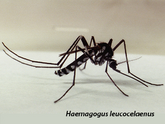| Haemagogus | |
|---|---|
| Scientific classification | |
| Domain: | Eukaryota |
| Kingdom: | Animalia |
| Phylum: | Arthropoda |
| Class: | Insecta |
| Order: | Diptera |
| Family: | Culicidae |
| Subfamily: | Culicinae |
| Tribe: | Aedini |
| Genus: | Haemagogus Williston, 1896[1] |
| Type species | |
| Haemagogus splendens | |
| Synonyms | |
|
Cacomyia Coquillett, 1906 | |

Haemagogus is a genus of mosquitoes in the dipteran family Culicidae. They mainly occur in Central America and northern South America (including Trinidad), although some species inhabit forested areas of Brazil, and range as far as northern Argentina. In the Rio Grande Do Sul area of Brazil, one species, H. leucocelaenus, has been found carrying yellow fever virus. Several species have a distinct metallic sheen.
Species of this genus are vectors in the transmission of sylvan or "jungle" yellow fever, which is often carried by monkeys in the forest canopies. Haemagogus species have also been found to carry the Mayaro virus and Ilheus virus.[2][3] As these mosquitoes, in general, have relatively long lives, they can transmit viruses for long periods.
They tend to live in the canopy of forests, where the female lays eggs in between layers of tree bark or in cut bamboo. The eggs adhere to the surface and when submerged by rain water develop into larvae.
- ^ a b Williston, Samuel Wendell (1896). "On the Diptera of St. Vincent (West Indies)". Transactions of the Entomological Society of London. 1896: 253–446, pls. 8–14. Retrieved 3 June 2018.
- ^ The Arthropod-borne Viruses of Vertebrates: An Account of The Rockefeller Foundation Virus program 1951-1970. 1973, pp. 133, 153. Max Theiler and W. G. Downs. Yale University. ISBN 0-300-01508-9.
- ^ "Haemagogus mosquito may be a vector for Diseases Database".